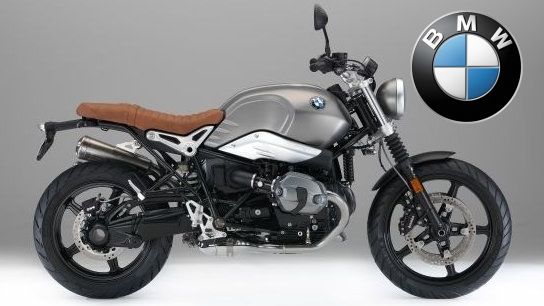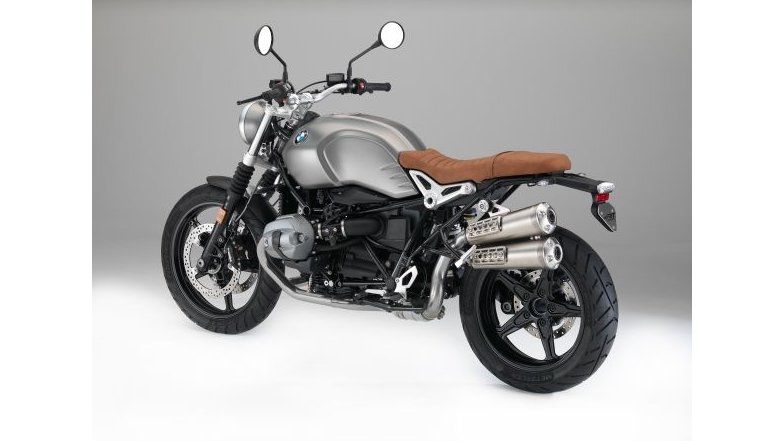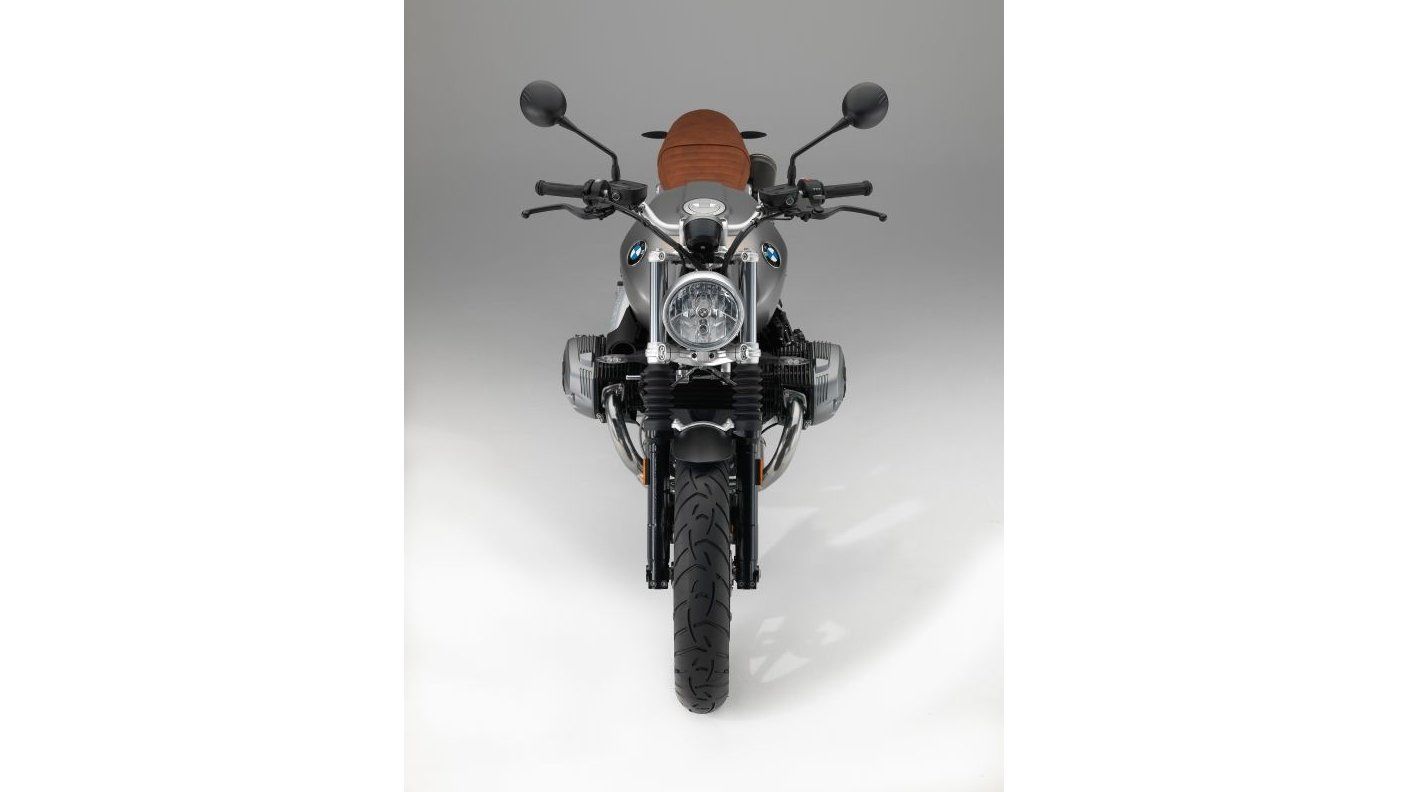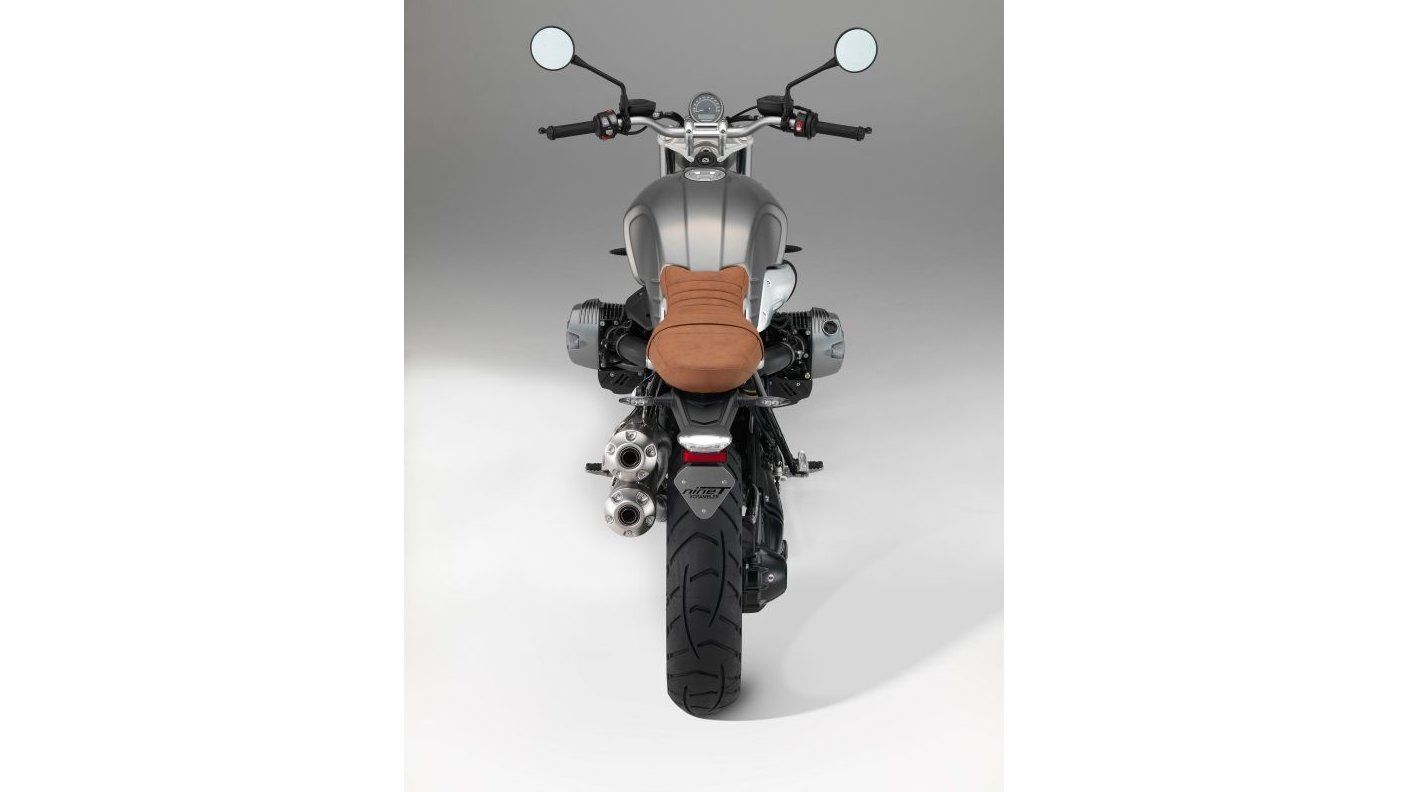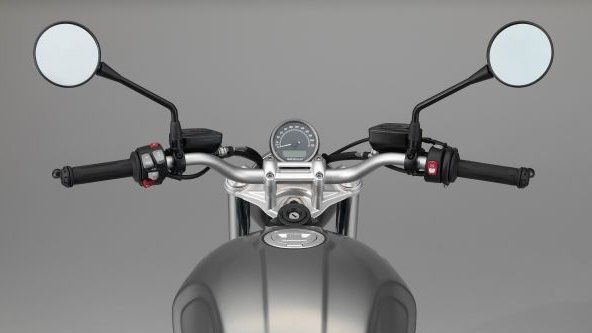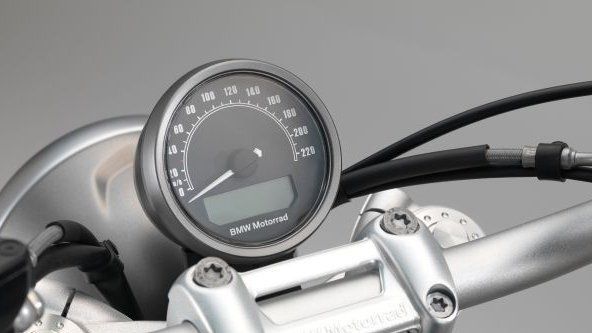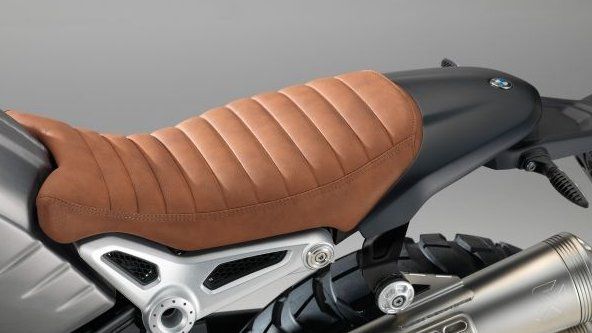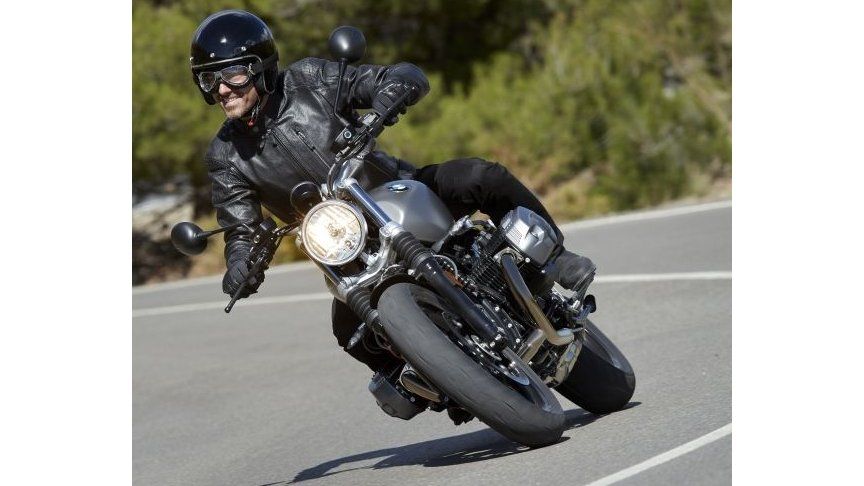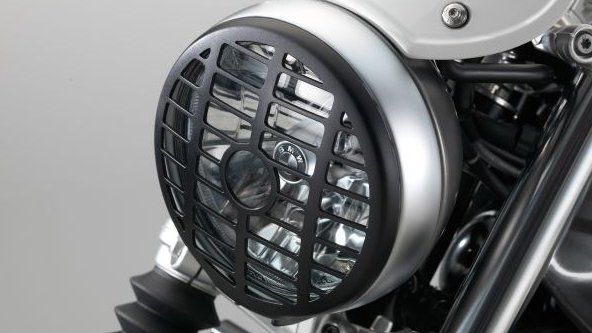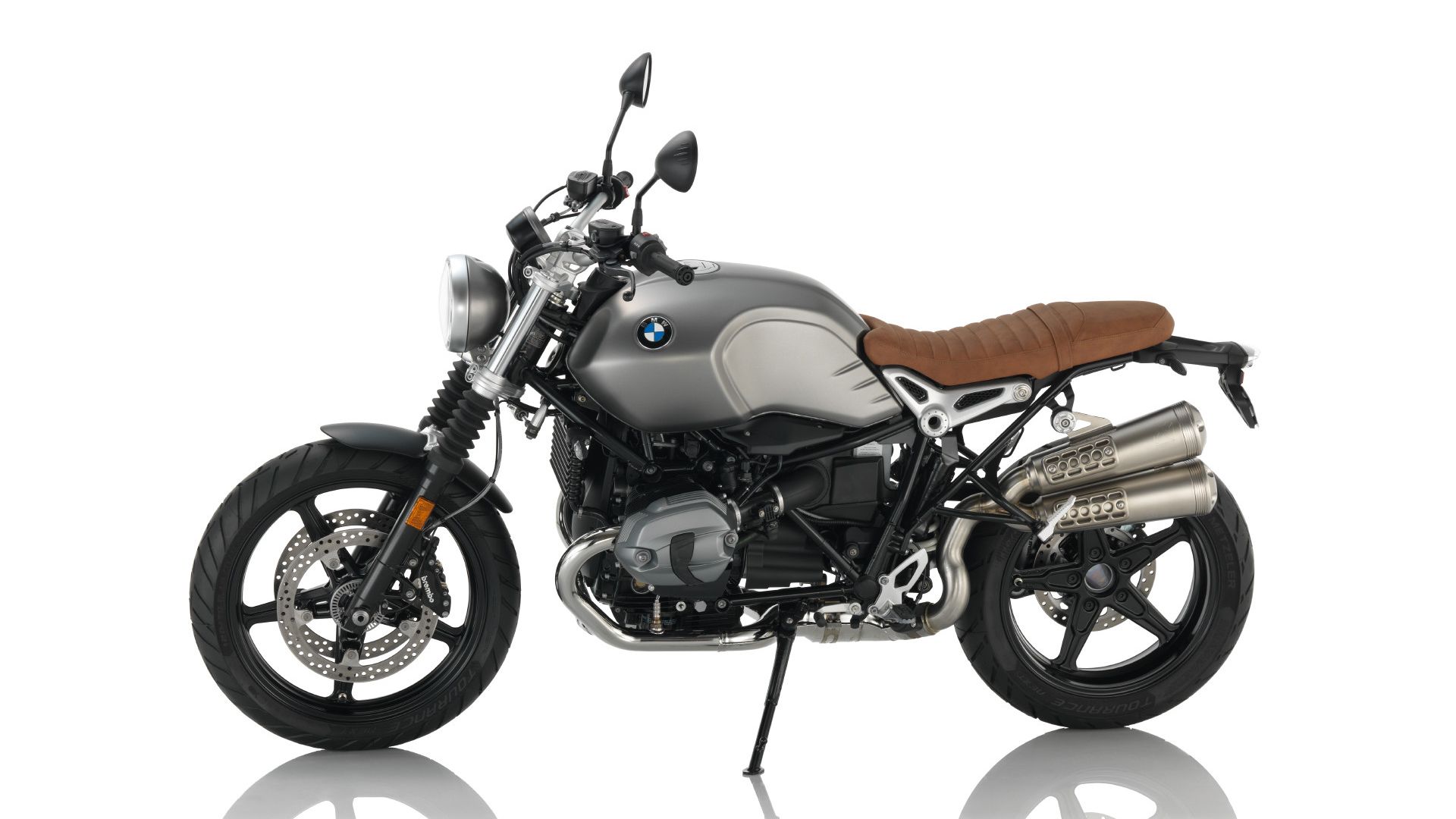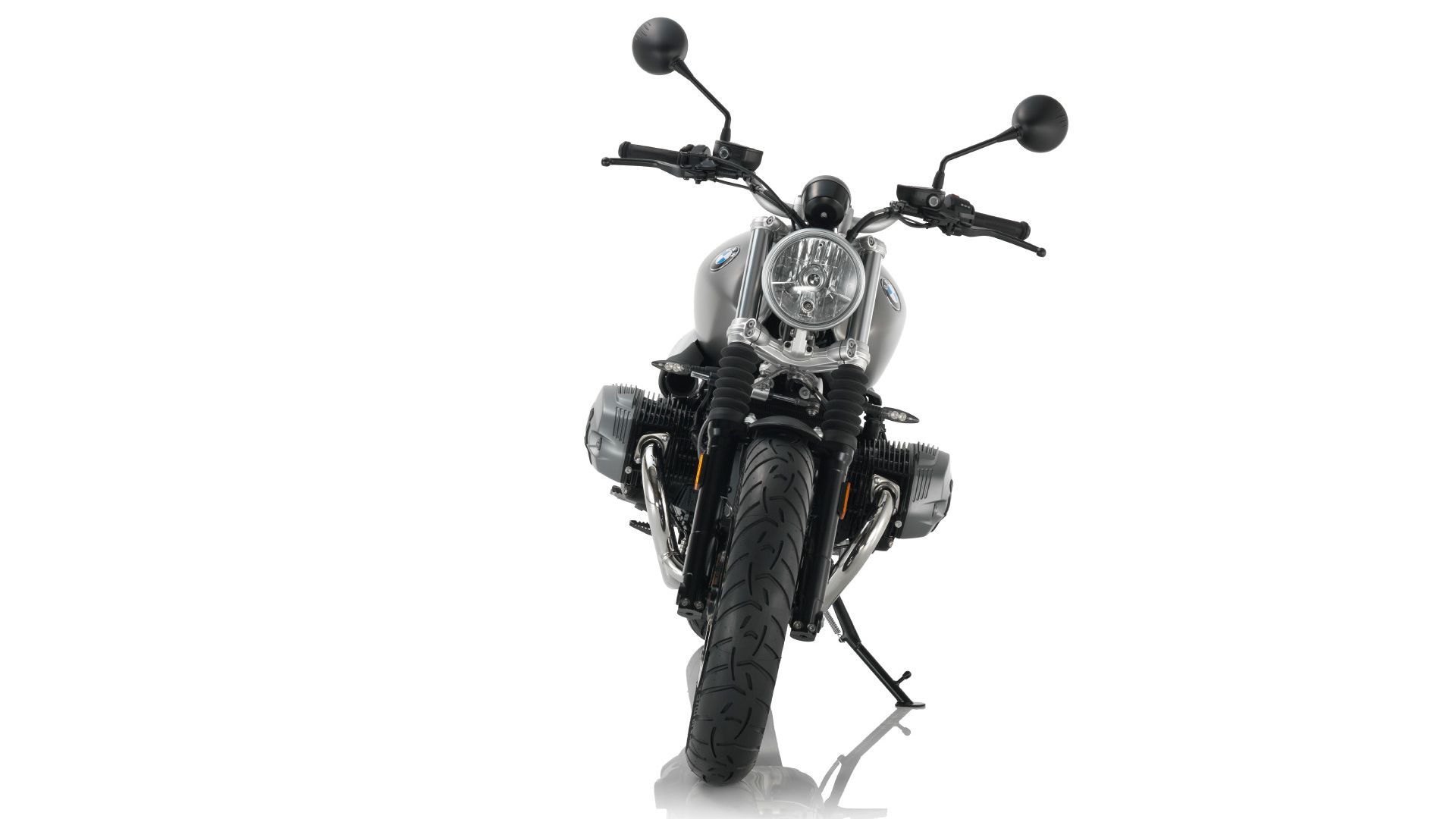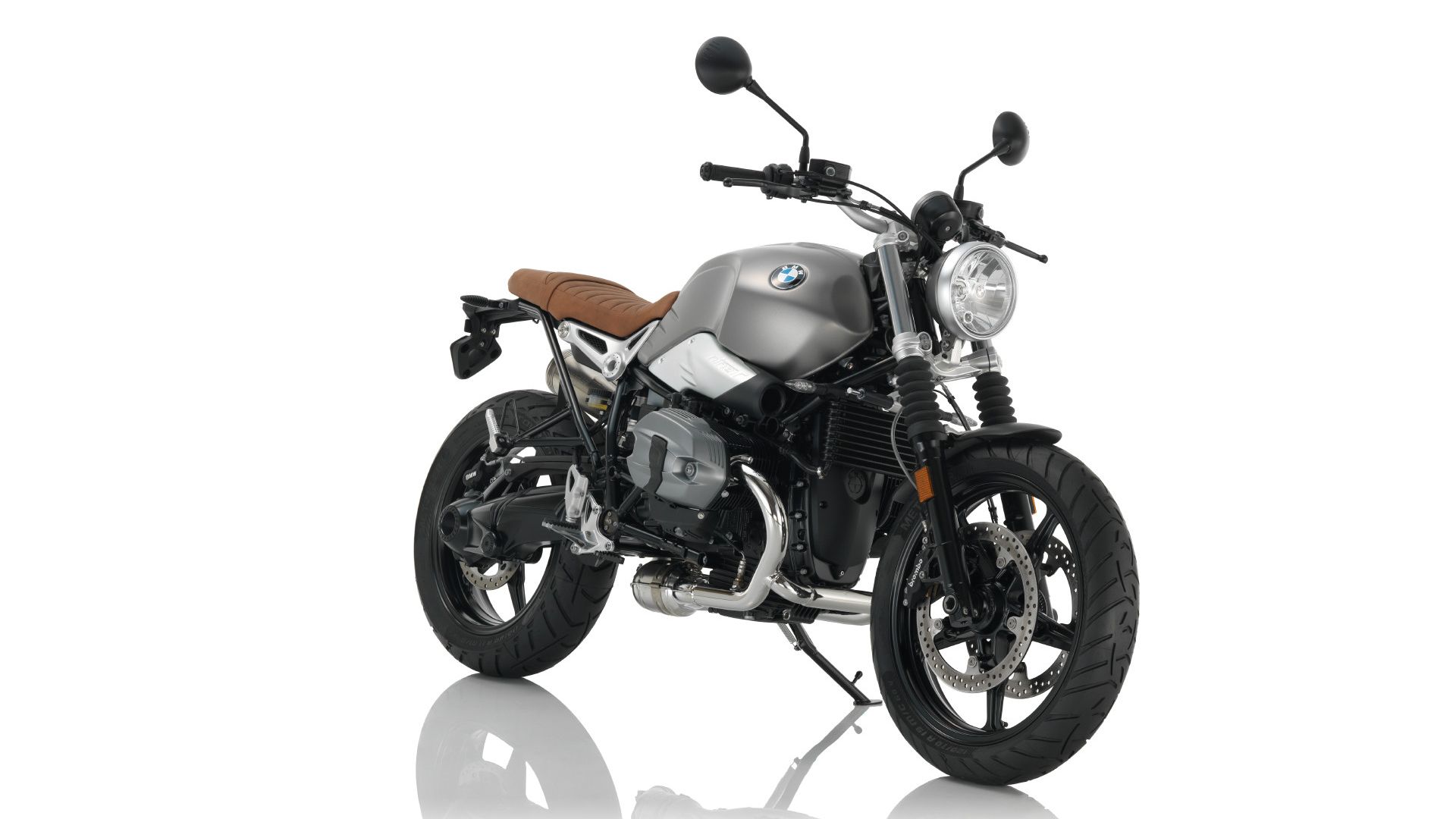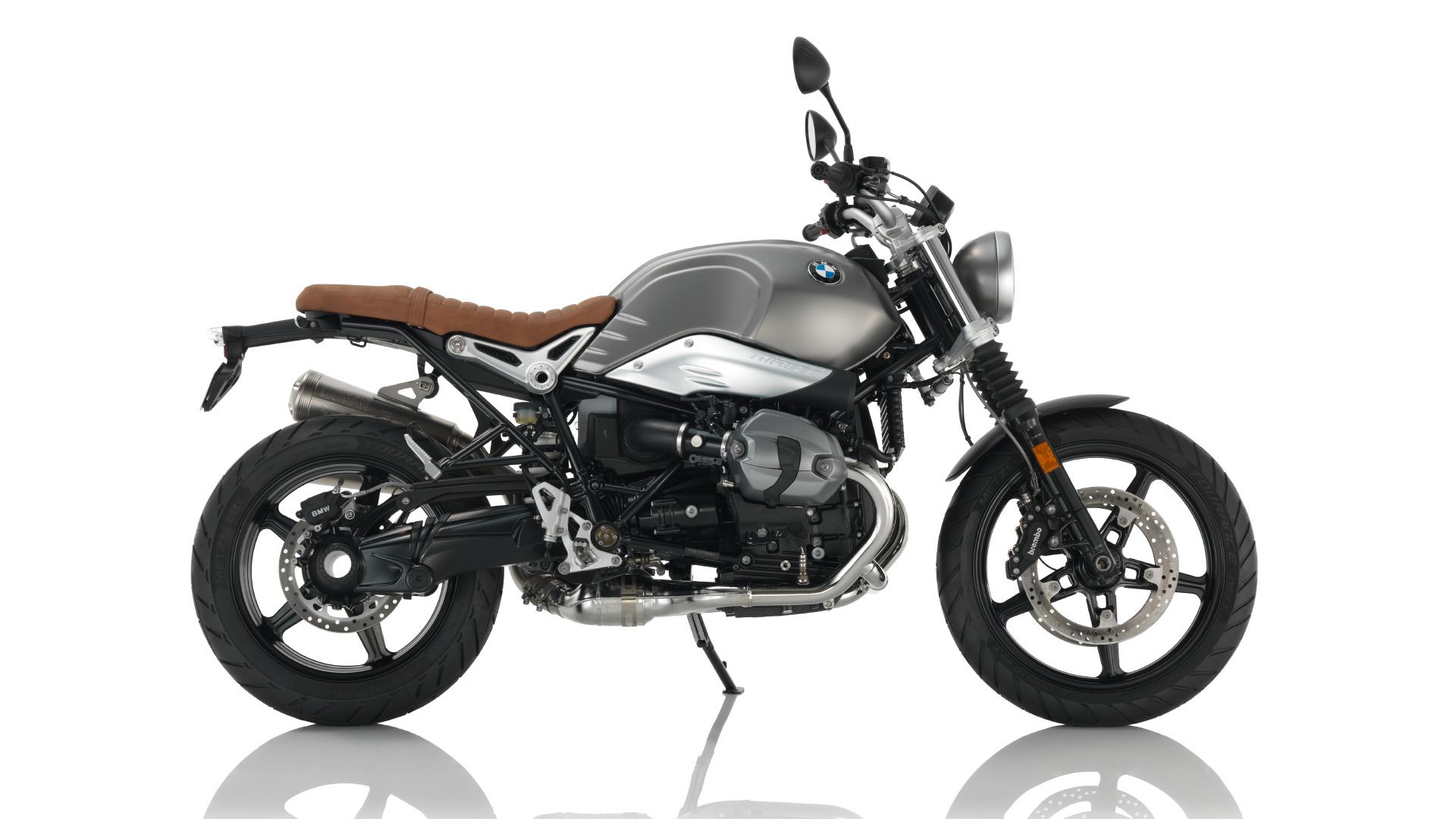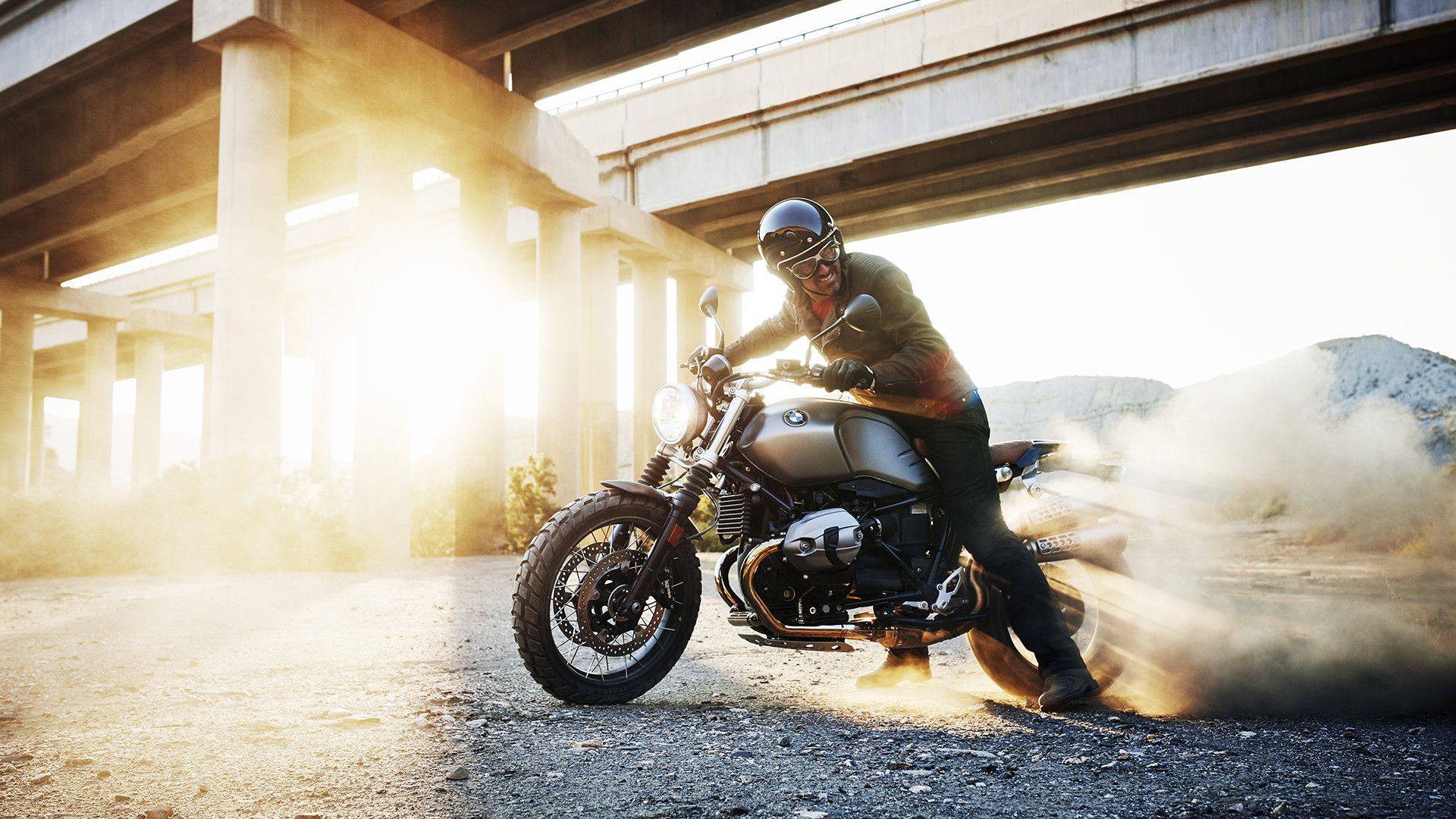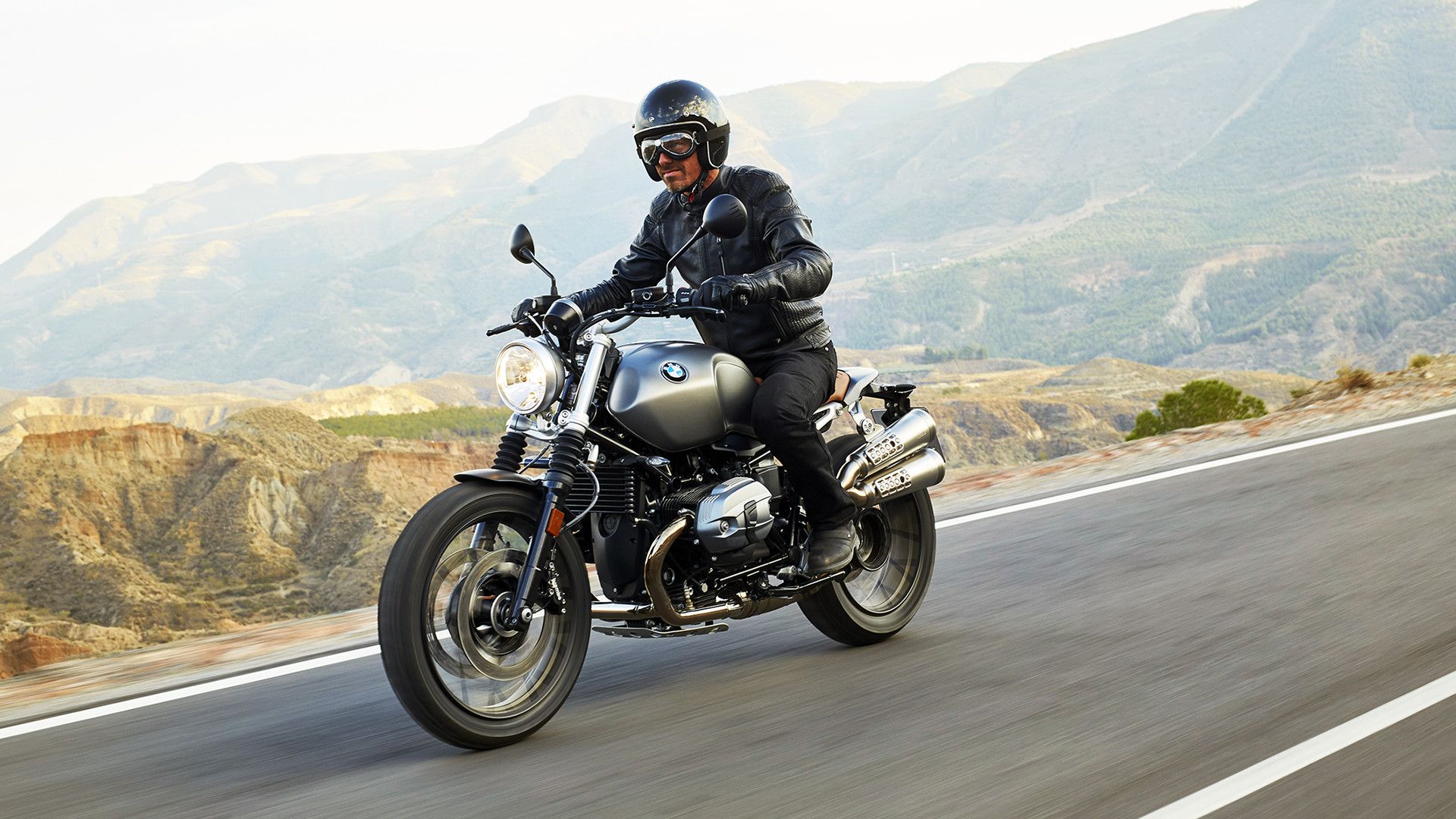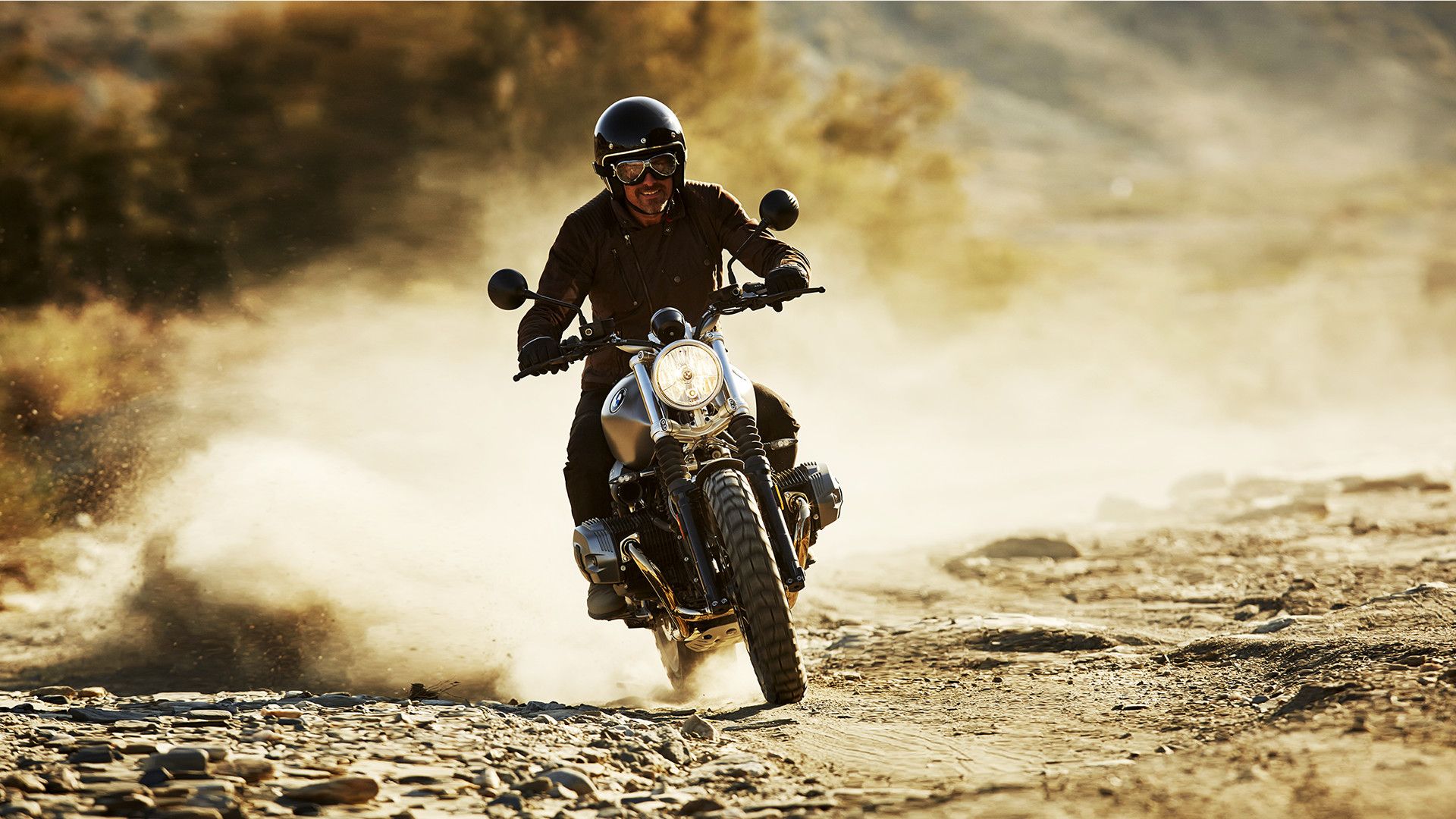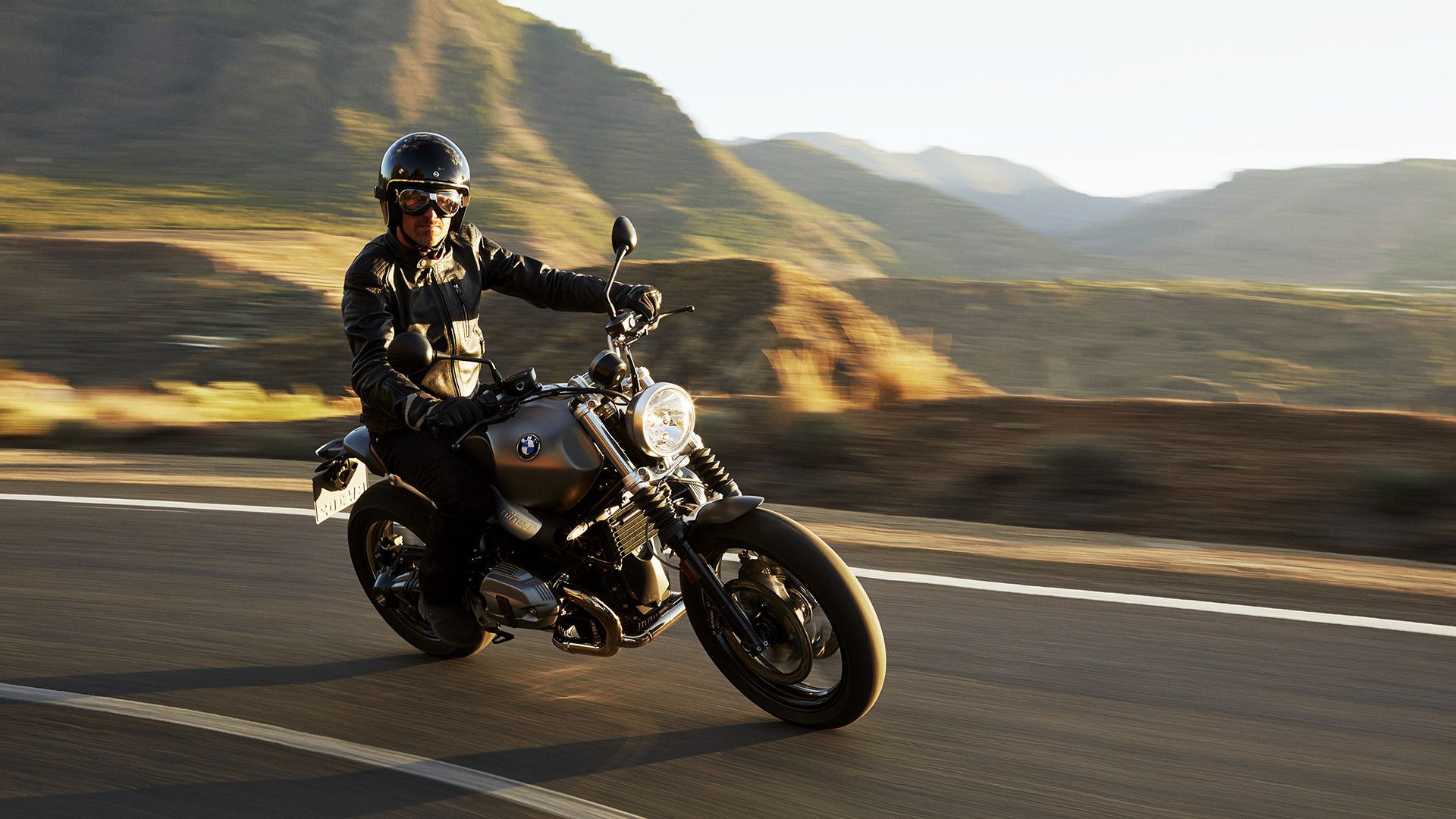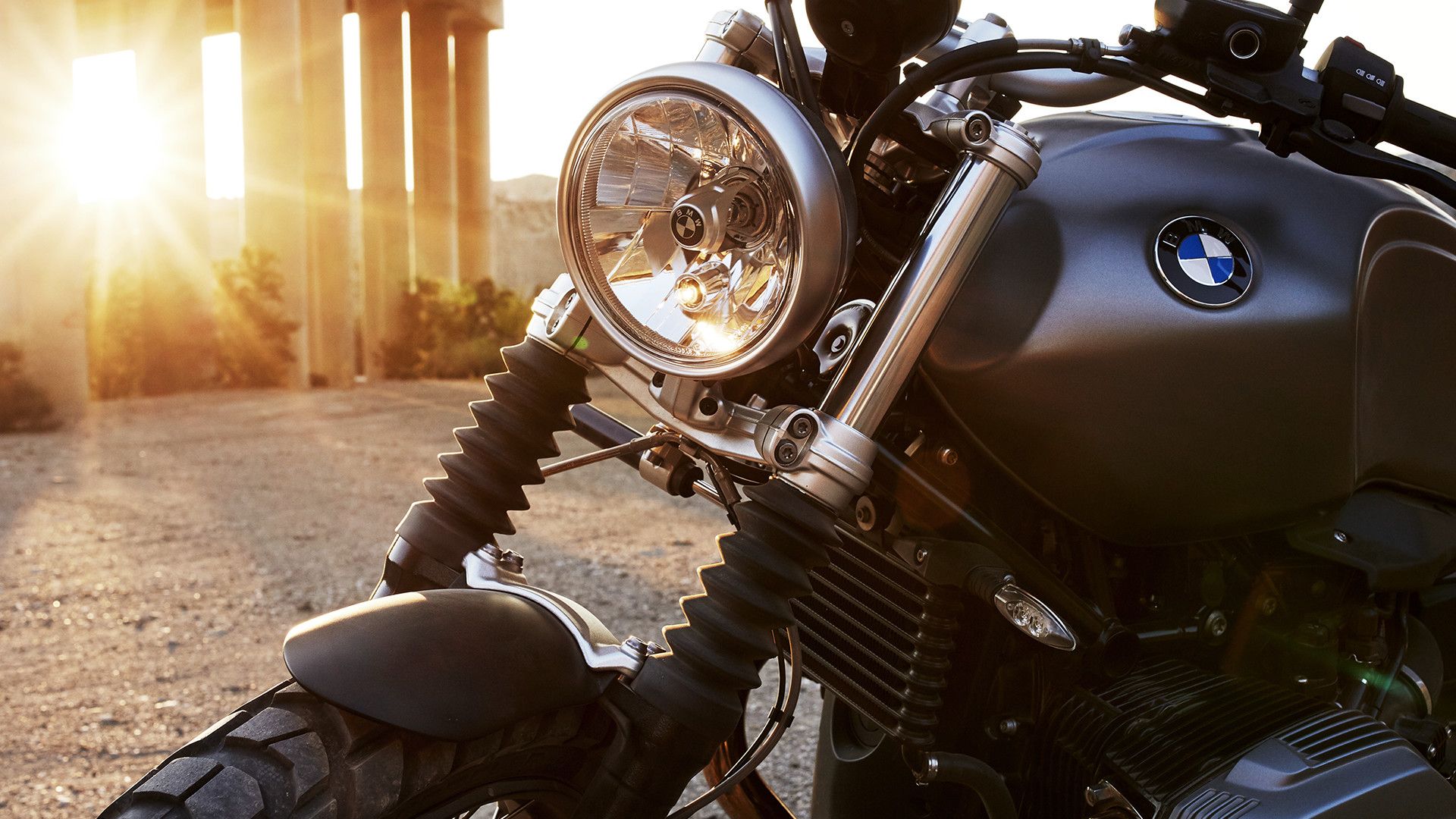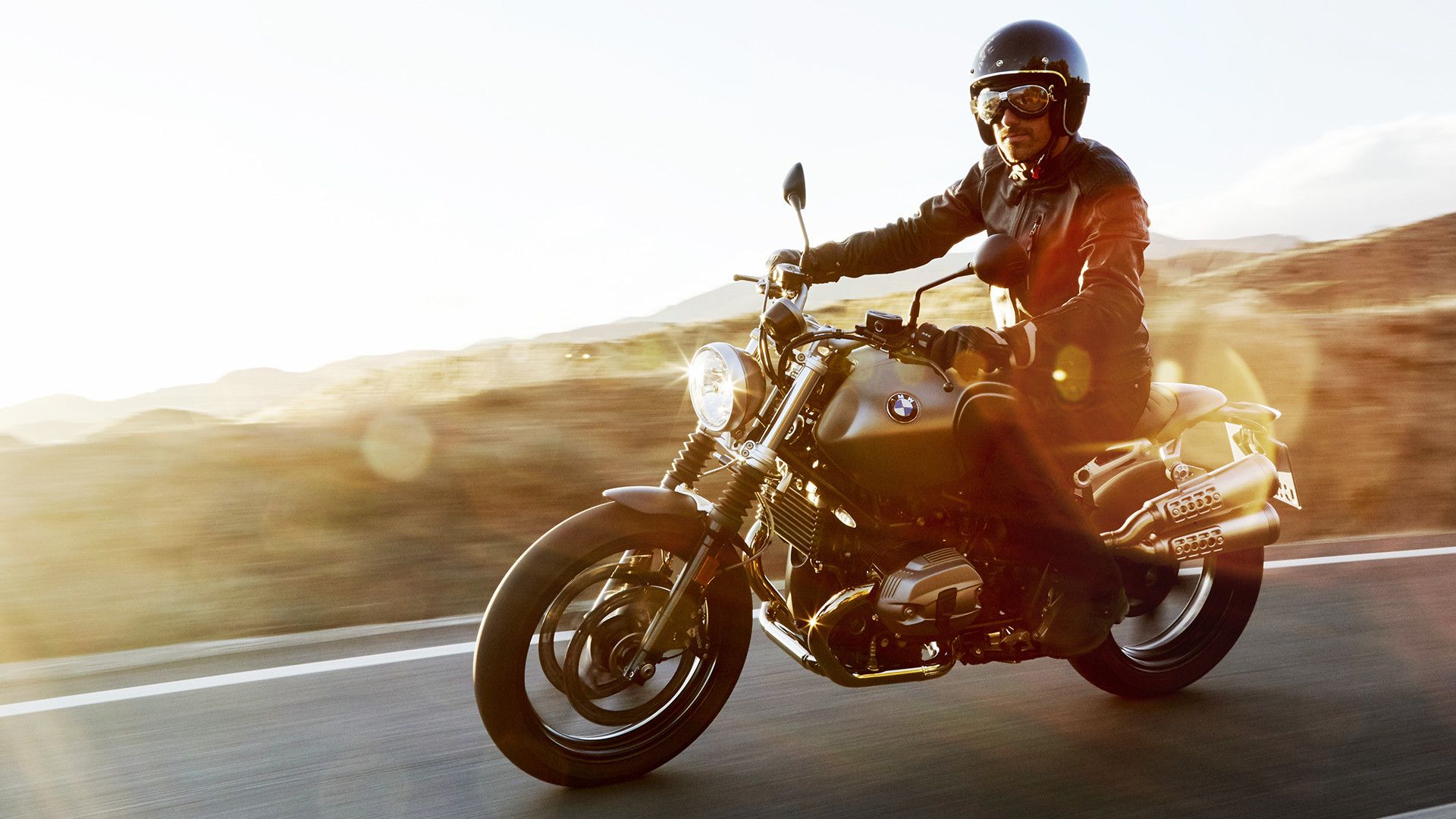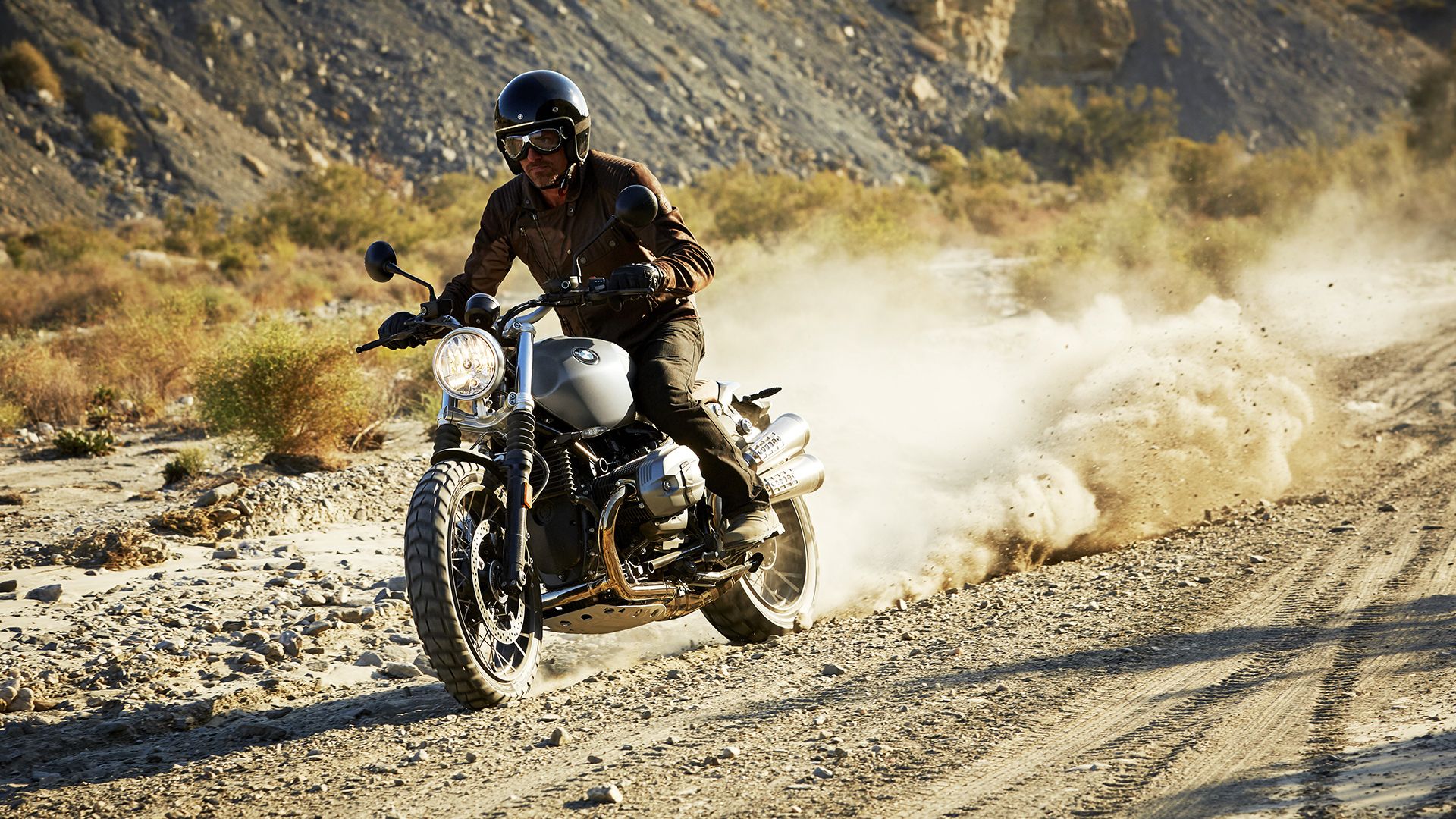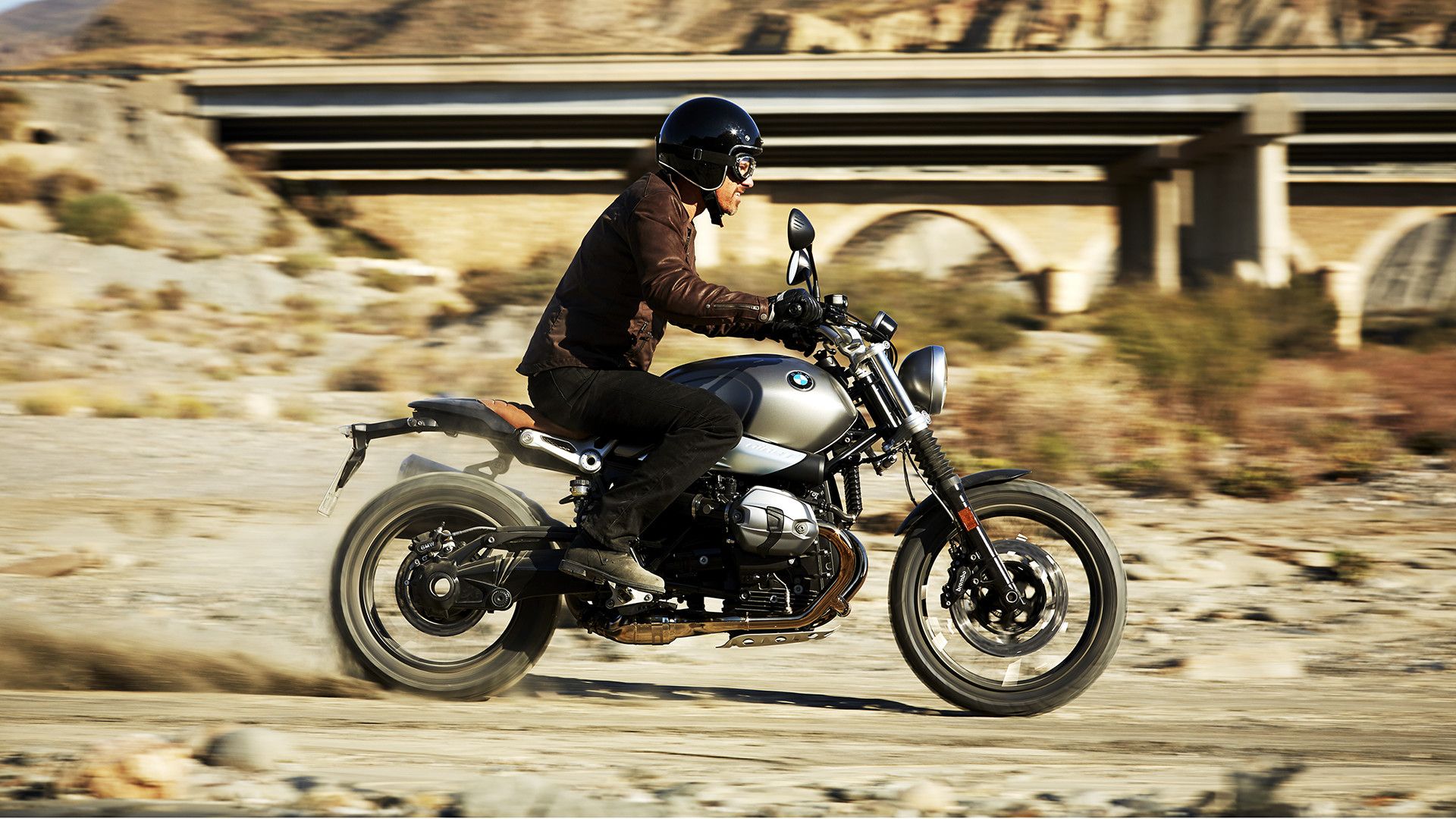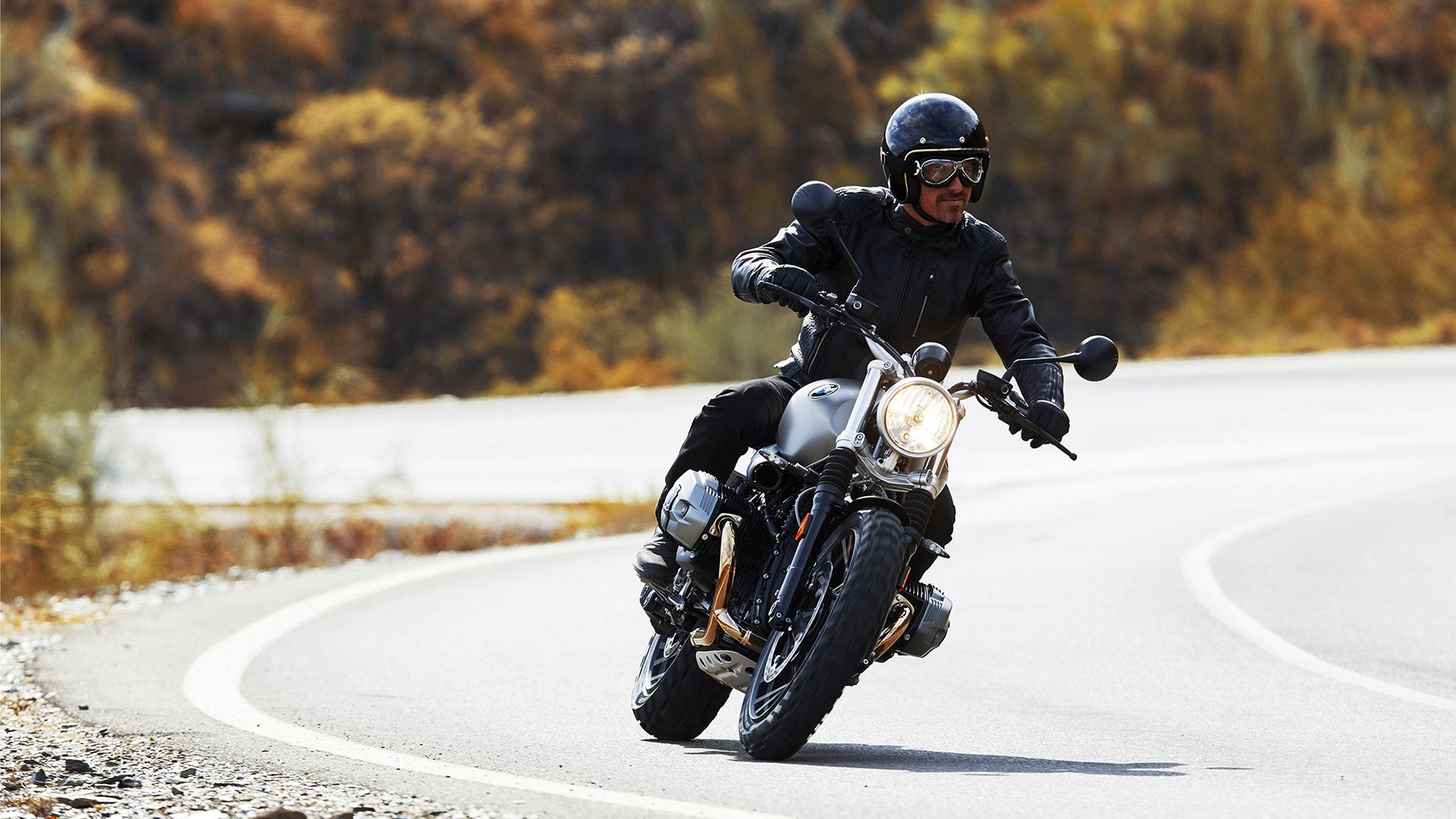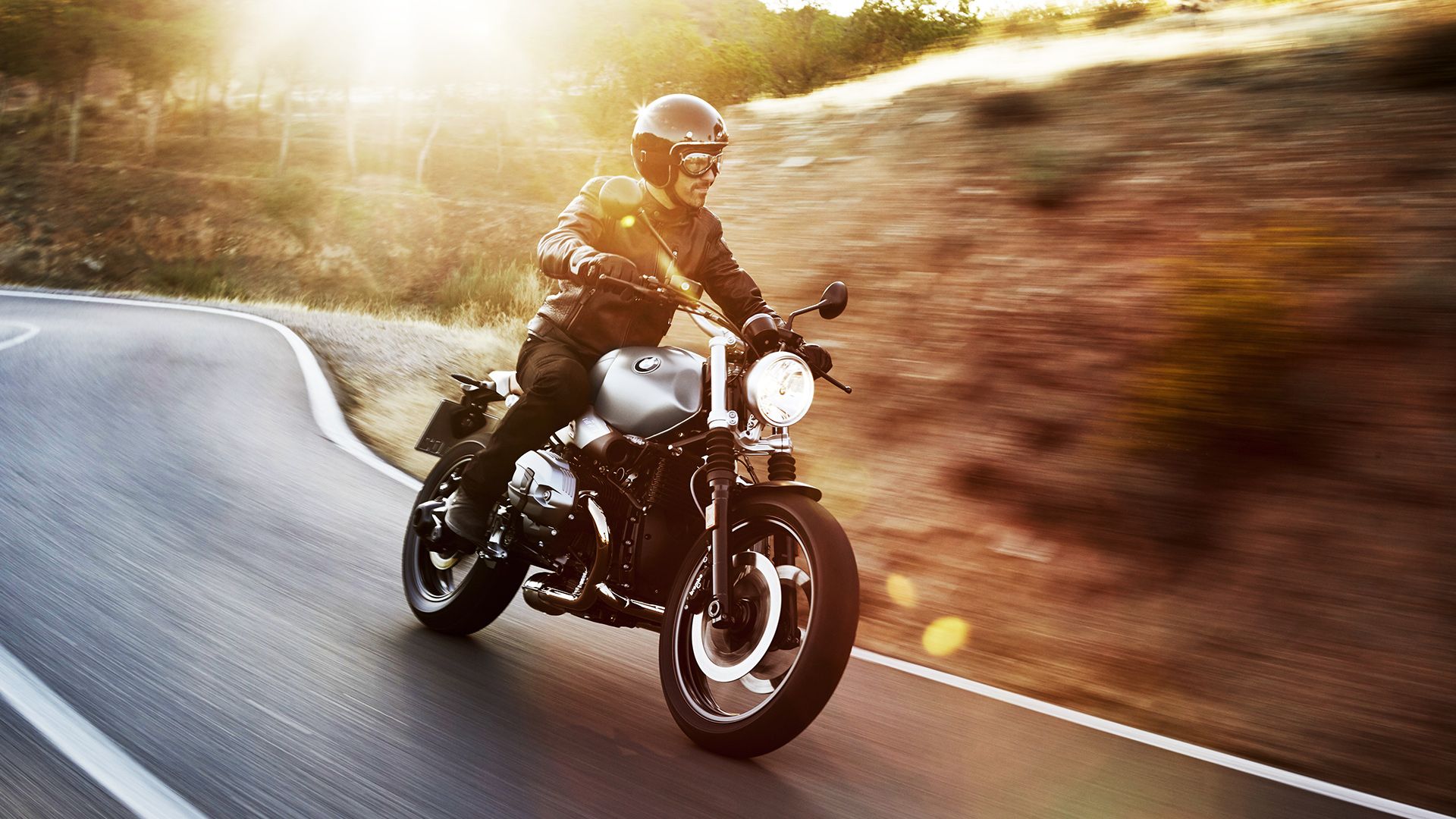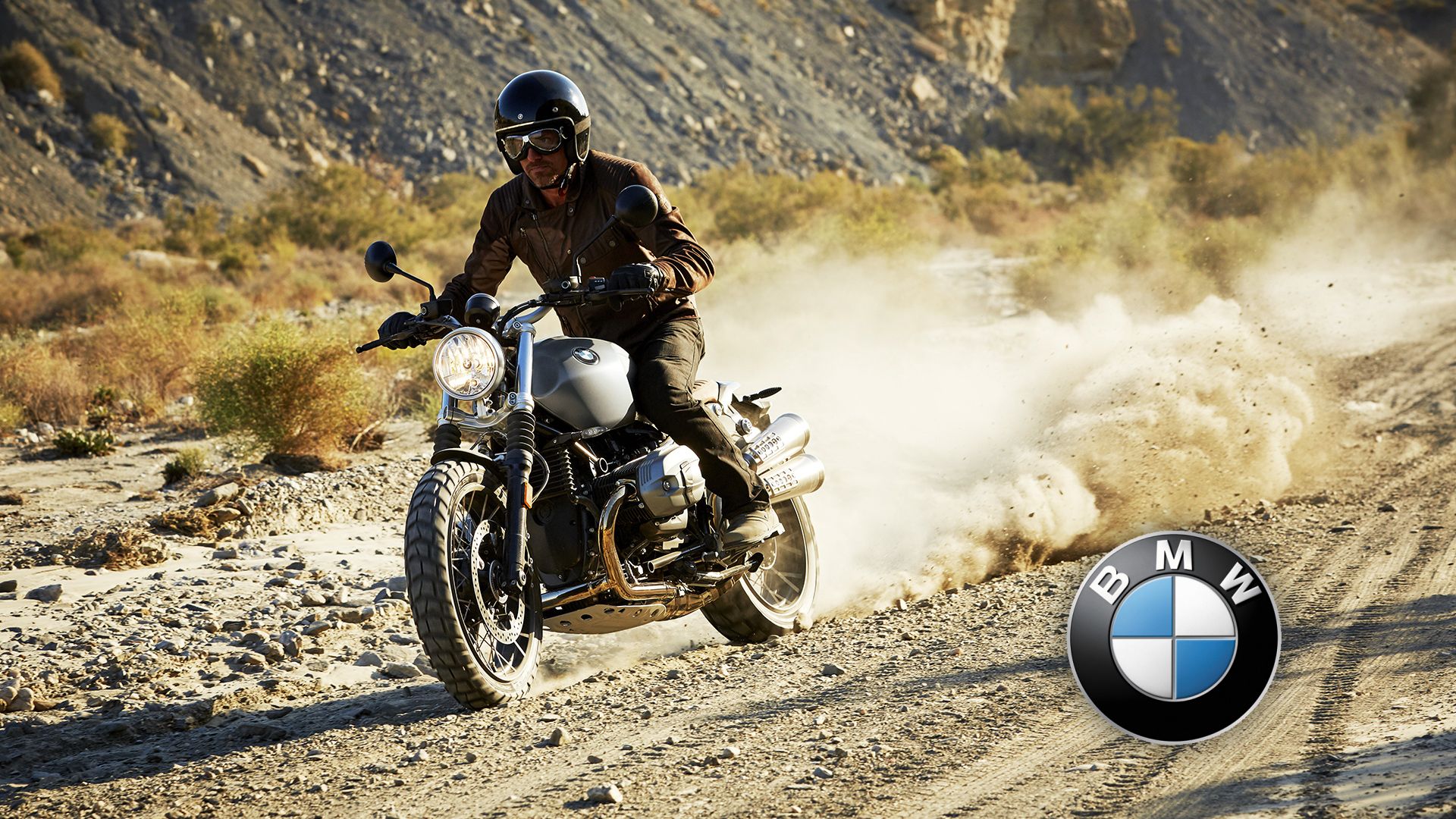The new-from-2016, R nineT Scrambler from the Bayerische Motoren Werke (BMW Motorrad) rolls into 2020 still based on a general design popular from the '50s all the way through the '70s. The Scrambler embodies the form of the original scramblers, while borrowing from the 1951 Beemer R 68. The result is a ride that invokes nostalgia in those old enough to remember the originals and subsequent variants, but also appeals to a younger crowd who appreciates classic looks coupled with updated performance and more reliable technology than its antique predecessors.
2016 - 2020 BMW R nineT Scrambler
- Make: Array
- Model: 2016 - 2020 BMW R nineT Scrambler
- Segment: Array
- Engine/Motor: Flat twin
- [do not use] Vehicle Model: Array
BMW R nineT Scrambler Design
BMW cooked up the R nineT Scrambler with plenty of classic references. Note the 19-inch front wheel and fork gaiters up front, followed by the low fuel tank complete with race-tastic knee indentions and minimal saddle. The engine dominates the overall look and seems to push all other design aspects almost into the realm of afterthought, but since this is a Beemer, you can bet everything was calculated down to the millimeter.
Short-rise handlebars combine with the seat and footrest positions to put the rider in an aggressive, jockey position; perfect for attacking corners with extreme prejudice, but it also represents a compromise. One of the design features common among the modern dual-sport bikes is the ability to comfortably stand up on the pegs and maintain control of the bike. However, the rider triangle on the R nineT forces the rider into a “hands heavy” position that prevents any sort of subtlety with the steering. Still, that's a minor gripe, and it will only affect a small percentage of potential riders.
BMW R nineT Scrambler Chassis
Not all historical tie-ins are aesthetic in nature. Though there were some factory-made scramblers back in the day, many of them were purposefully-modded, homemade customs. BMW kept this in mind when laying out the frame on the R nineT Scrambler. Tubular-steel modules bolt together to form the structure with the stressed engine as the keystone. A removable pillion strut offers a quick change from solo to two-up, but the real magic is in the modular nature of the frame that allows for radical customization possibilities.
Even with all its built-in character, the R nineT Scrambler is built to serve as a blank canvas for riders looking to truly express themselves through their rides. The 28.5-degree steering head makes for 4.3 inches of trail and a nimble ride well in keeping with some of the earliest scrambler home-jobs built on street/sport platforms.
A pair of four-pot, Brembo calipers pinch the 320 mm front brake discs, and BMW's own twin-pot caliper binds the 265 mm rear disc, all under the watchful eye of Beemer's proprietary ABS system. I would be remiss if I didn't mention that most dual-sports on the market come with some sort of feature that provides a number of ABS modes with different levels of intervention, and some allow the rear ABS to be deactivated entirely. No such features exist for the R nineT Scrambler that I have seen, which isn't a deal breaker. It just makes for a rawer ride and more direct connection between man and machine.
The same goes with the suspension. The factory slapped a set of 43 mm usd forks with just the bare minimum of the inner fork tube exposed. While this undoubtedly provides plenty of stiffness and stability under duress, I don't see any sort of variable suspension adjustments, leaving us with a one-ride-fits-all machine, at least up front.
A Paralever on the single-sided, aluminum swingarm works with the coil-over monoshock to buoy the rear, and it does come with adjustable spring preload and rebound damping for a bit of flexibility. At 4.7 inches of wheel travel front and 5.5 inches on the rear, the suspension won't tolerate Supercross-style shenanigans very well, but that's okay. T'aint that kind of bike.
The deep-groove tires complete the rolling chassis and reveal the split personality of the Scrambler by their off-road grip and generous flats for maneuvers on civilized roads.
|
Frame: |
Tubular Steel Space Frame, Engine Self-Supporting |
|
Suspension, Front: |
43 mm Inverted Telescopic Fork, 4.7-inch travel |
|
Suspension, Rear: |
BMW Paralever, 5.5-inch travel |
|
Rake: |
28.5 degrees |
|
Trail: |
4.3 inches |
|
Brakes, Front: |
Brembo, Hydraulic Dual 320 mm Disc |
|
Brake, Rear: |
Hydraulic Single 265 mm Disc |
|
ABS: |
BMW Motorrad ABS |
|
Wheel, Front: |
Cast Aluminum, 3.0 x 19 inches |
|
Wheel, Rear: |
Cast Aluminum, 4.5 x 17 inches |
|
Tire, Front: |
120/70 ZR19 |
|
Tire, Rear: |
170/60 ZR17 |
BMW R nineT Scrambler Drivetrain
Nothing says Beemer quite like those cylinder heads sticking out from each side, and the Scrambler carries that iconic look with its classic, air- and oil-cooled, flat-twin engine. The over-square engine runs with a 101 mm bore and 73 mm stroke for a total of 1,170 cc. Performance numbers are almost predictable. The mill cranks out 110 horsepower at 7,800 rpm and 88 pound-feet of torque at six grand, maintaining the torquey reputation of this configuration. Quad-valve heads with DOHC actuation control aspiration, and the electronic fuel injection manages the mix.
For 2020, BMW took the Automatic Stability Control out of options and added it to standard equipment for a measure of safety that we know as traction control. BMW stuffed the gearbox with six speeds worth of helical-cut gears for smooth and quiet engagement that gives you 52 mpg at 55 mph, and a top speed of 125+ mph.
|
Engine: |
Air/Oil-Cooled Two-Cylinder DOHC Boxer, Four Valves per Cylinder |
|
Displacement: |
1,170 cc |
|
Bore x Stroke: |
101 mm x 73 mm |
|
Maximum Horsepower: |
110 hp @ 7,800 rpm |
|
Maximum Torque: |
88 lb-ft @ 6,000 rpm |
|
Compression: |
12.0:1 |
|
Fuel Delivery: |
50 mm Throttle Bodies |
|
Engine Control: |
BMS-MP |
|
Exhaust: |
Closed-Loop Three-Way Catalytic Converter |
|
Clutch: |
Hydraulically-Activated Dry Clutch |
|
Transmission: |
Constant-Mesh Six-Speed |
|
Primary Ratio: |
1.737 |
|
Final Drive: |
Universal Shaft |
BMW R nineT Scrambler Price
MSRP on the 2020 BMW R nineT Scrambler is $12,995. With ASC added as standard equipment, so maybe I should say it's still $12,995 even with the upgrade.
|
Standard Equipment: |
19-inch Front Wheel, ABS, Automatic Stability Control (ASC), Adjustable Rear Suspension Spring Preload, Adjustable Rear Shock Absorber Rebound, Cast Aluminum Wheels, Disc Brakes, Fork Gaiters, LED Tail Light, Modular Frame Concept, One Piece Bench Seat, Power Socket, Smoked Grey Turn Signal Lenses, Speedometer, Steel Fuel Tank, Steering Damper |
|
Warranty: |
One-Year Limited Warranty: |
|
Color: |
|
|
└ 2018: |
Monolith Metallic Matte |
|
└ 2019: |
Stereo Metallic Matte |
|
└ 2020: |
Stereo Metallic Matte, Option 719 Black Storm Metallic/Aurum, Option 719 Black Storm Metallic/Light White |
|
Price: |
$12,995 |
BMW R nineT Scrambler Competitor
|
|
right> |
There are a handful of manufacturers jumping into the resurgent scrambler market, so I had plenty of choices for a competitor, and I settled on the new Street, not so much for its similarities as its differences.
Triumph Street Scrambler
Visually, they both show dual-purpose capability with a competitive bent and a little dose of Mad Max for good measure. Both rides sport knee reliefs in the tank, but Triumph takes it a step further with a grip pad for the high-side knee. Practical, plus it just looks cool.
Triumph opted for a smaller engine on its Scrambler, and the newly-updated, 900 cc liquid-cooled, parallel-twin mill produces 59 pound-feet of torque at a low 3,200 rpm and 65 horsepower at 7,500 rpm. That's a sight lower than the Beemer's 86 pound-feet of torque and 110 horsepower, but to be expected given the displacement difference. Triumph went with the good ol' chain drive, which may not be as sexy as BMW's shaft drive, but it is easy to adjust and maintain. All a matter of taste, I suppose.
No surprises in the sticker category either. Beemer rolls out its Scrambler for just $12,995, but the Triumph Street Scrambler falls a skosh short at $11,000, and suddenly the smaller engine doesn't seem like such a bad idea. This is within entry-level range, and expands the net downward for new Scrambler converts. Experienced riders and riders with the budget for the Beemer will likely appreciate the increased power and torque delivery. Really, these bike almost compliment each other by covering different slices of this market segment, and between the two, there is something for everyone. Once again, it's all a matter of taste and needs.
He Said
“This ride seems to exude dogged determination to me, hence the Mad Max reference, something to give pursuit down the pavement one minute, and go tearing across the desert like a scalded dog the next. It carries that distinctive Beemer vibe with a liberal dose of devil-may-care and a historic soul. While I never quite made friends with the idea of having my rocker boxes and heads sticking out -- it seems so vulnerable to me -- I really like this ride. It has attitude, but not punky attitude, more like the supreme self-confidence borne of years of experience.”
She Said
My wife and fellow writer, Allyn Hinton, says, "These scramblers are coming back in a big way -- these precursors to dual sport and adventure bikes. It's an on-road bike with off-road attitude for folks that didn't want the limitation of coloring inside the lines."
BMW R nineT Scrambler Specifications
|
Engine & Drivetrain: |
|
|
Engine: |
Air/Oil-Cooled Two-Cylinder DOHC Boxer, Four Valves per Cylinder |
|
Displacement: |
1,170 cc |
|
Bore x Stroke: |
101 mm x 73 mm |
|
Maximum Horsepower: |
110 hp @ 7,800 rpm |
|
Maximum Torque: |
88 lb-ft @ 6,000 rpm |
|
Compression: |
12.0:1 |
|
Fuel Delivery: |
50 mm Throttle Bodies |
|
Engine Control: |
BMS-MP |
|
Exhaust: |
Closed-Loop Three-Way Catalytic Converter |
|
Alternator: |
720 W |
|
Clutch: |
Hydraulically-Activated Dry Clutch |
|
Transmission: |
Constant-Mesh Six-Speed |
|
Primary Ratio: |
1.737 |
|
Final Drive: |
Universal Shaft |
|
Chassis: |
|
|
Frame: |
Tubular Steel Space Frame, Engine Self-Supporting |
|
Suspension, Front: |
43 mm Inverted Telescopic Fork, 4.7-inch travel |
|
Suspension, Rear: |
BMW Paralever, 5.5-inch travel |
|
Rake: |
28.5 degrees |
|
Trail: |
4.3 inches |
|
Brakes, Front: |
Brembo, Hydraulic Dual 320 mm Disc |
|
Brake, Rear: |
Hydraulic Single 265 mm Disc |
|
ABS: |
BMW Motorrad ABS |
|
Wheel, Front: |
Cast Aluminum, 3.0 x 19 inches |
|
Wheel, Rear: |
Cast Aluminum, 4.5 x 17 inches |
|
Tire, Front: |
120/70 ZR19 |
|
Tire, Rear: |
170/60 ZR17 |
|
Dimensions & Capacities: |
|
|
Length: |
85.6 inches |
|
Width (with Mirrors): |
34.6 inches |
|
Seat Height: |
32.2 inches |
|
Wheelbase: |
60.1 inches |
|
GVWR: |
947 Pounds |
|
Curb Weight: |
485 Pounds |
|
Fuel Tank Capacity: |
4.5 Gallons |
|
Fuel Economy: |
44 mpg |
|
Recommended Fuel: |
Premium Unleaded |
|
0-60 mph: |
3.5 seconds |
|
Top speed: |
124 mph |
|
Details: |
|
|
Standard Equipment: |
19-inch Front Wheel, ABS, Automatic Stability Control (ASC), Adjustable Rear Suspension Spring Preload, Adjustable Rear Shock Absorber Rebound, Cast Aluminum Wheels, Disc Brakes, Fork Gaiters, LED Tail Light, Modular Frame Concept, One Piece Bench Seat, Power Socket, Smoked Grey Turn Signal Lenses, Speedometer, Steel Fuel Tank, Steering Damper |
|
Warranty: |
One-Year Limited Warranty: |
|
Color: |
|
|
└ 2018: |
Monolith Metallic Matte |
|
└ 2019: |
Stereo Metallic Matte |
|
└ 2020: |
Stereo Metallic Matte, Option 719 Black Storm Metallic/Aurum, Option 719 Black Storm Metallic/Light White |
|
Price: |
$12,995 |
Further Reading
BMW Motorrad
|
|
link=mot1398> |
Read more BMW Motorrad news.


